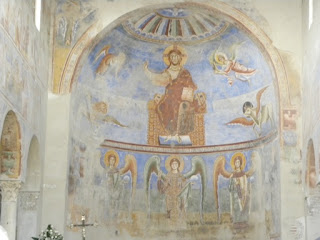
Nook of Naples: Catholic Churches number in the hundreds here. Open to everyone, they provide quiet reprieve from the frenetic city traffic and display stunning works of art for free. And they also often transport visitors back through centuries of medieval, Byzantine, and ancient history.
The Basilica Benedettina di S. Michele Arcangelo, located in the outskirts of Capua, used to be an impressive Temple of Diana. The church lies at the bottom of a hilly area, known as 'Tifata' that during ancient times was densely forested. Rich with oak trees and spring waters, the cult of Diana -- goddess of the wood and hunt -- spread here.
We still don't know exactly when construction of this temple began. Scholars say that active building work took place at the end of the fourth century B.C and the beginning of the third century B.C. According to an inscription still visible on the floor, the Romans rebuilt the temple in 74 B.C. The date that the temple was transformed into a church is unknown. According to a literary tradition lacking historical evidence, the Longobards built a church consecrated to the Archangel Michael about the sixth century A.D. By 1065 the Norman, Richard I built a monastery here.

The church itself is interesting testimony to the fact that once Christianity took hold in Campania, the worship of gods and goddesses didn't immediately eclipse, but rather was slowly absorbed into the predominant religion. The cult of Mithras, for example, whose temple can still be visited in Capua, came from Persia and was very popular in the Roman empire. Worshippers celebrated the birthday of Mithras every 25th of December. Is this coincidence or did the early Christians adopt this date in order to gain more followers? (After all, the Bible gives no indication of Jesus' actual birth date.) More importantly, ancient temples and their materials were used to build new churches, certainly thereby bringing down the costs of construction.
Mysteries abound about this church because few manuscripts still exist detailing its construction. But walking along its ancient floor, past its columns, and admiring its Byzantine frescoes, a visitor can visually travel through time.



2 comments:
You write about all the sites I want to see, but never have a chance to visit! I love reading about them here and looking at the photos.
Thanks, KC! This church is absolutely stunning and worth a visit. And back at'cha -- your blog is a smorgasbourg of places I'll never visit, except through the wonderful pictures on your blog.
Saluti!
Post a Comment